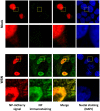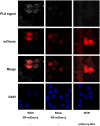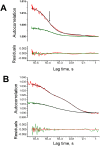Time-Resolved Visualisation of Nearly-Native Influenza A Virus Progeny Ribonucleoproteins and Their Individual Components in Live Infected Cells
- PMID: 26978069
- PMCID: PMC4792379
- DOI: 10.1371/journal.pone.0149986
Time-Resolved Visualisation of Nearly-Native Influenza A Virus Progeny Ribonucleoproteins and Their Individual Components in Live Infected Cells
Abstract
Influenza viruses are a global health concern because of the permanent threat of novel emerging strains potentially capable of causing pandemics. Viral ribonucleoproteins (vRNPs) containing genomic RNA segments, nucleoprotein oligomers, and the viral polymerase, play a central role in the viral replication cycle. Our knowledge about critical events such as vRNP assembly and interactions with other viral and cellular proteins is poor and could be substantially improved by time lapse imaging of the infected cells. However, such studies are limited by the difficulty to achieve live-cell compatible labeling of active vRNPs. Previously we designed the first unimpaired recombinant influenza WSN-PB2-GFP11 virus allowing fluorescent labeling of the PB2 subunit of the viral polymerase (Avilov et al., J.Virol. 2012). Here, we simultaneously labeled the viral PB2 protein using the above-mentioned strategy, and virus-encoded progeny RNPs through spontaneous incorporation of transiently expressed NP-mCherry fusion proteins during RNP assembly in live infected cells. This dual labeling enabled us to visualize progeny vRNPs throughout the infection cycle and to characterize independently the mobility, oligomerization status and interactions of vRNP components in the nuclei of live infected cells.
Conflict of interest statement
Figures






Similar articles
-
Influenza A virus progeny vRNP trafficking in live infected cells studied with the virus-encoded fluorescently tagged PB2 protein.Vaccine. 2012 Dec 7;30(51):7411-7. doi: 10.1016/j.vaccine.2012.09.077. Epub 2012 Oct 10. Vaccine. 2012. PMID: 23063830
-
The C-Terminal Domains of the PB2 Subunit of the Influenza A Virus RNA Polymerase Directly Interact with Cellular GTPase Rab11a.J Virol. 2022 Mar 9;96(5):e0197921. doi: 10.1128/jvi.01979-21. Epub 2022 Jan 12. J Virol. 2022. PMID: 35019720 Free PMC article.
-
Nuclear import of influenza A viral ribonucleoprotein complexes is mediated by two nuclear localization sequences on viral nucleoprotein.Virol J. 2007 Jun 4;4:49. doi: 10.1186/1743-422X-4-49. Virol J. 2007. PMID: 17547769 Free PMC article.
-
Structure and assembly of the influenza A virus ribonucleoprotein complex.FEBS Lett. 2013 Apr 17;587(8):1206-14. doi: 10.1016/j.febslet.2013.02.048. Epub 2013 Mar 13. FEBS Lett. 2013. PMID: 23499938 Review.
-
Role of sulfatide in influenza A virus replication.Biol Pharm Bull. 2015;38(6):809-16. doi: 10.1248/bpb.b15-00119. Biol Pharm Bull. 2015. PMID: 26027821 Review.
Cited by
-
Robo1 Forms a Compact Dimer-of-Dimers Assembly.Structure. 2018 Feb 6;26(2):320-328.e4. doi: 10.1016/j.str.2017.12.003. Epub 2018 Jan 4. Structure. 2018. PMID: 29307485 Free PMC article.
-
Application of Super-Resolution and Advanced Quantitative Microscopy to the Spatio-Temporal Analysis of Influenza Virus Replication.Viruses. 2021 Feb 2;13(2):233. doi: 10.3390/v13020233. Viruses. 2021. PMID: 33540739 Free PMC article. Review.
-
Identification of small molecule inhibitors for influenza a virus using in silico and in vitro approaches.PLoS One. 2017 Mar 8;12(3):e0173582. doi: 10.1371/journal.pone.0173582. eCollection 2017. PLoS One. 2017. PMID: 28273150 Free PMC article.
-
The Feat of Packaging Eight Unique Genome Segments.Viruses. 2016 Jun 17;8(6):165. doi: 10.3390/v8060165. Viruses. 2016. PMID: 27322310 Free PMC article. Review.
-
Friend or Foe: The Role of the Cytoskeleton in Influenza A Virus Assembly.Viruses. 2019 Jan 10;11(1):46. doi: 10.3390/v11010046. Viruses. 2019. PMID: 30634554 Free PMC article. Review.
References
Publication types
MeSH terms
Substances
LinkOut - more resources
Full Text Sources
Other Literature Sources
Miscellaneous

